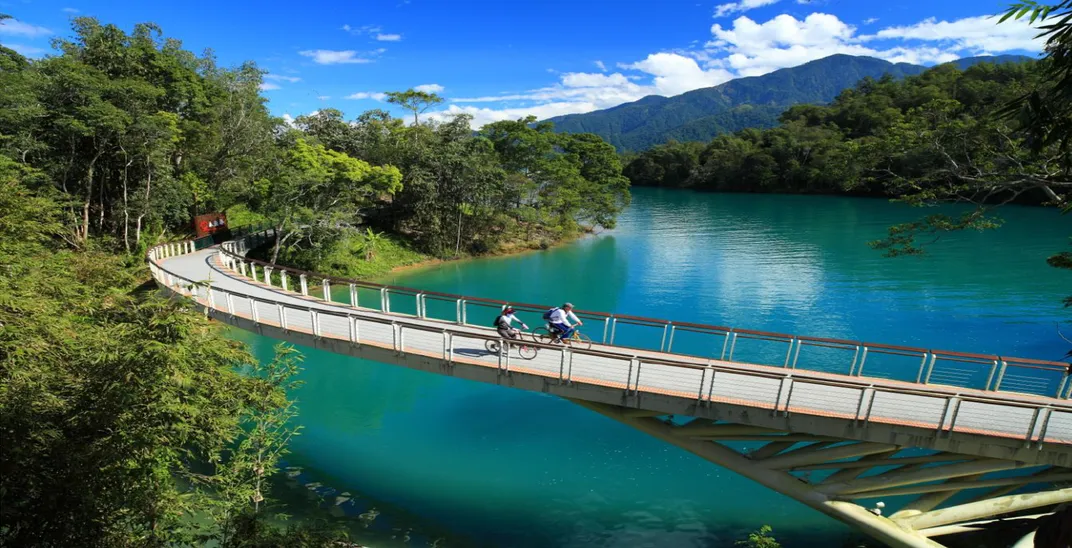Nestled in the western foothills of Taiwan’s Central Range, Sun Moon Lake is a world unto itself, renowned for both its natural beauty and cultural heritage. Each day casts the lake in a different light, and every so often, some claim, the mountains that tower above it take the shape of two dragons fighting over a pearl.
Although today Sun Moon is Taiwan’s largest alpine lake, the area was once home to two separate bodies of water. Back in the 1930s when Taiwan was a colony of Japan, the Japanese erected a dam on one of the lakes to generate hydroelectric power. The operation, over time, raised the water level to create Sun Moon Lake in its current form: round like the sun at its eastern end and curved like the crescent moon at its western end.
The lake region can be explored by boat or cable car, but the best way to soak in the tranquil scenery is by bike. Designated, well-kept bikeways hug the lake's shore, and views of misty mountains, lush growth and floating pontoon islands have landed this network of twisting trails on lists of the most scenic cycling trails in the world.
The route around the entire lake can be pedaled in roughly three hours, but arguably the most beautiful portion is along the western shore, which is divided into two segments, the Yuetan and Xiangshan bikeways.
Both trails begin (and end) at the Xiangshan Visitor Center, a beautiful, sweeping building constructed by the Japanese architect Norihiku Dan to blend into the natural landscape. Bikes can be rented here at shops located across the street.
Yuetan Bikeway (8 km out and back):
Heading south from the Visitor Center, this path winds along the shore, offering great views of the Toushe Basin in the south, the Qinglong Mountains to the north and checkerboard-like fields of surrounding farmland. Across the mirror-like bay, cyclists can take in views of Xuanguang Temple before peddling on past the Toushe Dam to the turn-around point at Huantan Tunnel No. 1.
Xiangshan Bikeway (6 km out and back):
Cyclists heading north from the Visitor Center can take a slightly shorter, but no less beautiful route over several bridges and through lake-side parks. The white, wood-paved Yongjie and Tongxin Bridges offer sweeping views of the turquoise blue water. Further along, cyclists can look out over the lake to Lalu Island, considered to be the ancestral home of the Thao, the first people to inhabit the region. The turn-around point offers a chance to temporarily leave solitude behind and wander Shishe Pier, a vibrant shopping area packed with souvenir shops and restaurants.

For those taking the full tour around the lake, other notable stops include the Peacock Garden on the eastern shore. The garden features over 200 rare and beautiful birds of over 100 different species, including the Formosan blue magpie, the long-tailed pheasant, the black cootpeacocks and, of course, peacocks.
Nearby a cable car runs from the base of the lake to the Formosan Aboriginal Culture Village, delighting riders with panoramic views of the lake and mountains. Part cultural village, part amusement park, the site pays homage to the scenic area’s aboriginal origins and features everything from traditional song and dance performances to a roller coaster. The Thao people were the first to inhabit the region, followed by the Han majority. Today both groups live in the area, each influencing the other while maintaining their separate identities.
On the north shore, Wenwu Temple boasts sweeping vistas of the lake from its back terrace. Asia’s largest stone lions guard this Confucian temple, and sculpted shrubs decorate its gardens. For cyclists with energy to spend, ascend the three hundred and sixty-six steps, nicknamed the “Stairway to Heaven” and representing the days of the year, from the path to the temple. Wind chimes inscribed with blessings dangle from the guardrails and glisten in the sunlight.
Though host to over six million visitors every year, Sun Moon Lake nevertheless preserves pastoral qualities and a magic all its own.
Explore more spectacular rides in the Bicycle Kingdom.

/https://tf-cmsv2-smithsonianmag-media.s3.amazonaws.com/filer/23/40/234029c9-54af-4718-a882-bf69f16df78f/sun-moon-lake-taiwan-2.jpg)